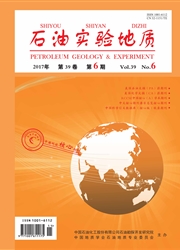

 中文摘要:
中文摘要:
以明确华北地台中奥陶世沉积格局分布及演化特征为目的,基于层序地层学理论,将华北地台东部中奥陶统划分为5个三级层序,并以三级层序为单位进行沉积相分析和岩相古地理编图。从层序地层的等时性出发,研究了本区中奥陶世岩相古地理特征。华北地台东部中奥陶世以持续海侵为主,层序地层的发展受海侵规模、时间及短暂海退的影响,中部地层发育最为齐全。古地理格局总体上表现为南北高、中间低,早期至晚期演化具有一定的继承性和明显的发展性。古地理环境受构造和海平面变化综合作用的影响,随着海侵扩大,云坪沉积减少,局限台地和开阔台地占据绝对优势。各期沉积相的分布格局有所差异,但整体而言,继承性明显,南北两侧的隆升格局造成南北分化显著,沉积相带南北对称,开阔台地常为南北两侧的局限台地所夹持,反映了构造隆升背景下沉积环境对海平面变化的敏感性。沉积过程的多旋回性和岩性组合的韵律性使得中奥陶统形成了多套有利的生储盖组合,中新生界保存条件较好的渤海湾盆地区为有利勘探区。
 英文摘要:
英文摘要:
We subdivided the Middle Ordovician in the eastern North China Platform into five level 3 sequences using sequence stratigraphic classification and correlation in order to determine clear sedimentary patterns and evolution characteristics. Sequence palaeogeographic maps of sedimentary facies were drawn,and the coastal evolutions were described using detailed sequence isochronism. Persistent transgression occurred in the eastern North China Platform during the Middle Ordovician. Lithofacies palaeogeography at five different stages of the Middle Ordovician took the appearance of some inherited features coexisting with significant evolution. Paleotopography of five stages kept on presenting higher in the north and south,and in central North China there developed a quite complete sedimentary sequence. The paleogeographical environment was influenced by tectonics and sea level changes and the distribution pattern of sedimentary facies in each phase was different. With the growing marine transgression,restricted platform and open platform were prominent. The north-south symmetry of sedimentary facies manifested as a restricted platform located on both sides of the open platform. Overall,it was the sensitive feedback to sea level change of the epicontinental sea coupled with crustal uplift,that controlled the sedimentary cyclicity and rhythmicity of lithologic associations,thus developing favorable source-reservoir-cap assemblages. It is worth mentioning,with beneficial MesoCenozoic preservation conditions,the Bohai Bay Basin is the most advantageous exploration area.
 同期刊论文项目
同期刊论文项目
 同项目期刊论文
同项目期刊论文
 期刊信息
期刊信息
